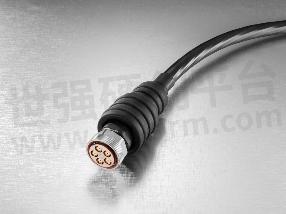What Coaxial Cables Should We Use on Military Vehicles?

Radio Frequency (RF) technology plays a critical role in military vehicle applications, providing essential communication, navigation, and targeting capabilities.
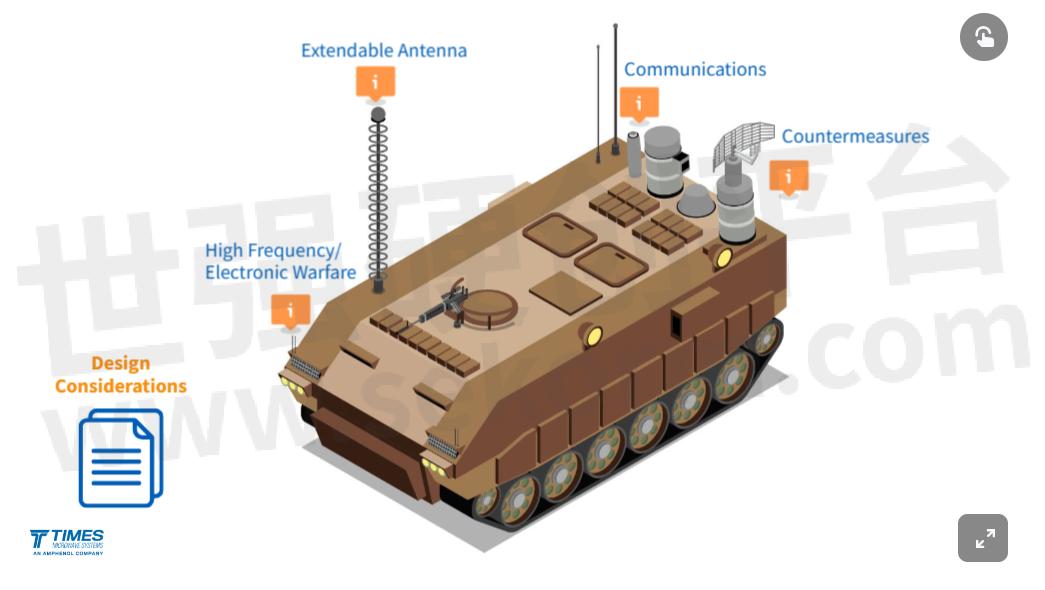
Fig.1
Communication systems
Military vehicles rely on RF communication systems to maintain contact with command centers and other vehicles. These systems often use VHF (Very High Frequency) and UHF (Ultra High Frequency) bands for voice and data transmission, ensuring real-time communication and coordination between various units.
Navigation and positioning
RF-based systems like GPS (Global Positioning System) provide accurate location and timing information for military vehicles. This enables precise navigation, coordination, and tracking of assets during military operations.
Electronic Warfare (EW)
RF technology is used in electronic warfare to disrupt or deceive enemy communication, navigation, and radar systems. Military vehicles can employ jamming equipment to interfere with enemy signals or use electronic countermeasures to protect against incoming threats.
Identification Friend or Foe (IFF) systems
RF-based IFF systems help military vehicles distinguish between friendly and enemy forces. These systems use encrypted RF signals to transmit and receive identification codes, reducing the risk of friendly fire incidents.
Wireless networking
Military vehicles can use RF-based wireless networking technologies, such as MANET (Mobile Ad Hoc Network), to establish a self-configuring and self-healing network. This allows vehicles to communicate with one another and share data, even when traditional communication infrastructure is unavailable or compromised.
Deployable Antennas
Feeder cables for military field deployable antennas need to be rugged enough to withstand the rigors of repeated reeling, while still providing good electrical performance and resistance to a variety of harsh environments. While corrugated copper cables and other cables designed for fixed installations are frequently used for these applications, they do not provide reliable long term performance.
Overall, RF technology is vital for the efficient operation of military vehicles, enhancing their communication, navigation, targeting, and electronic warfare capabilities. These applications are critical for successful military missions and ensuring the safety of personnel in the field.
What coaxial cables should I use on military vehicles?
The selection of appropriate coaxial cables for military vehicles depends on the specific application, frequency range, power handling capability, and environmental conditions. Military-grade coaxial cables should meet stringent requirements for durability, reliability, and performance. Some important factors to consider when selecting coaxial cables for military vehicles include:
Frequency range: Choose a coaxial cable that supports the frequency range required by the communication or radar systems used in the vehicle. For example, if the system operates in the VHF and UHF bands, select a cable that can handle these frequencies with minimal signal loss.
Power handling: Ensure that the cable can handle the power levels required by the vehicle’s communication or radar systems. High-power systems may require low-loss cables with better temperature handling capabilities.
Temperature: Ensure the cable can handle the temperatures of the vehicle and environment. Higher temperatures may require cables with better temperature handling performance.
Shielding: Military-grade coaxial cables should provide excellent shielding to minimize signal interference and ensure reliable communication. Double or even triple-shielded cables may be necessary for applications where interference is a significant concern.
Mechanical strength and durability: Cables used in military vehicles should be robust and able to withstand harsh environmental conditions, such as vibration, shock, extreme temperatures, and moisture. Look for cables with ruggedized construction, including high-quality materials like military-specification connectors and abrasion-resistant outer jackets. For applications that will frequently bend and move cables, consider cables designed to endure high flexure. Applications with chemical washdowns will require special jacket materials. Armored cables will have higher connector retention strength, increasing their durability.
Flexibility: Depending on the vehicle’s configuration and cable routing requirements, you may need a coaxial cable with high flexibility to accommodate tight bends and complex routing paths. Stranded center conductors offer increased flexibility but poorer insertion loss performance.
Environmental considerations: Common military environmental specifications to keep in mind include the type of cable jacket, IP67 or similar ratings on connectors, and if a cable needs to be rodent repellent. Other important environmental considerations include low smoke, zero halogen cable assemblies for spaces where air exchange is minimal and specialized cable jackets for environments that might endure nuclear, biological, and chemical (NBC) contamination and require chemical washdowns.
When selecting coaxial cables for military vehicles, it is essential to consult the system specifications and guidelines to ensure compatibility and optimal performance. Always work closely with cable manufacturers and system engineers to determine the best solution for your specific application.
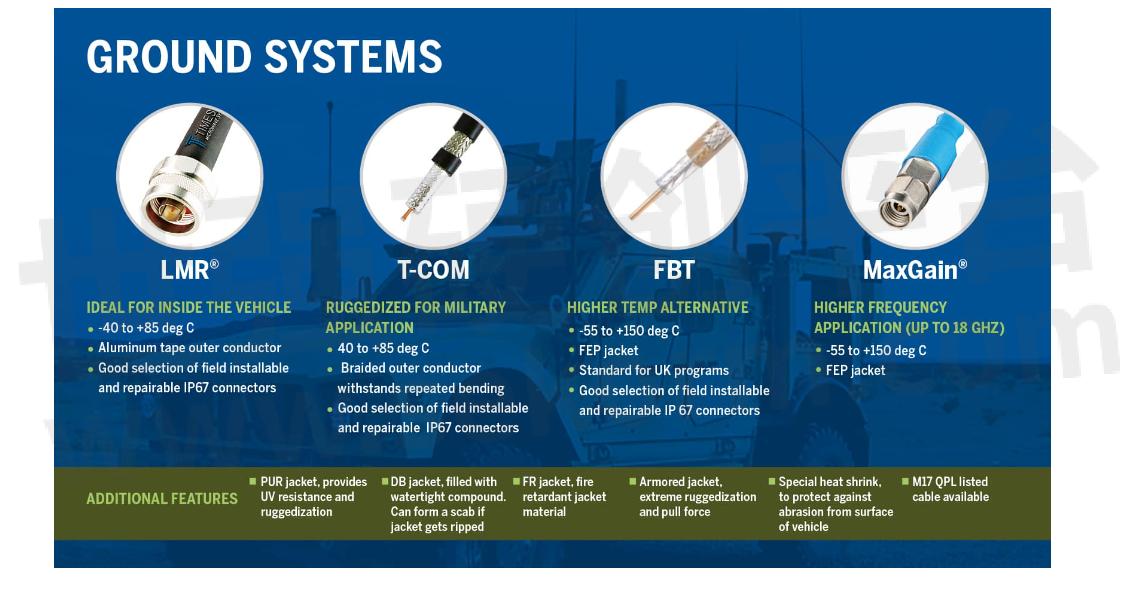
Fig.2
Cables for Military Ground Vehicles from Times Microwave Systems
The TCOM cable series has a foam dielectric and a silver-plated copper strip braid outer conductor. This allows these cables to withstand several thousand reelings on a diameter at least 20 times the cable diameter. The FlexStrand versions, with a stranded center conductor, have a lower bending moment and a longer bend life. A wide variety of connector types is available.
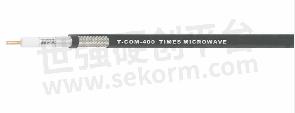
Fig.3
LMR® series
Our flagship LMR® cables are suitable for applications up to 6 GHz and provide excellent shielding and low signal loss. They are flexible, lightweight, and offer better performance than traditional RG series cables.

Fig.4
QEAM
The ultimate cable design for field deployable applications is the QEAM (Quick Erecting Antenna Mast) cable. This cable series is designed specifically for use in demanding, mission critical applications, where reeling and unreeling are required over a wide temperature range. Based on our MilTech aerospace cable assemblies, these assemblies are fully weather sealed and constructed in accordance with the requirements of MIL-T-81490. Heavy duty stainless steel connectors provide long term corrosion resistance and ruggedness.
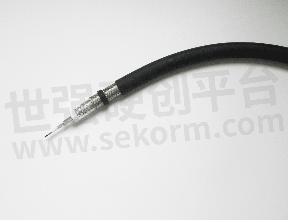
Fig.5
The PhaseTrack® Low Smoke (PTLS™) microwave assemblies are Low-smoke, zero-halogen cable assemblies designed for confined spaces such as ships and submarines. These assemblies provide exceptional phase temperature performance while meeting HF through K band frequency requirements, including an optimized version for minimum loss in the Ku band.
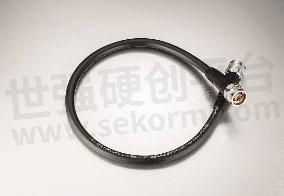
Fig.6
RG cables are MIL-Spec coax cables originally created to support WWII military applications. Depending on cable run length and shielding needed, RG cables are available for a variety of lower and higher frequencies.
RG-58
RG-213
RG-214
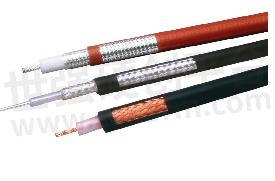
Fig.7
A bundled cable solution can help create the perfect flexible antenna jumper for applications requiring multiple runs. This design enables four or five individual cables to be fed into the back of an industry standard MQ4/MQ5 bundled connector, incorporating multiple RF ports and significantly reducing the number of cables that have to be hooked up.
Fig.8
Multiport and mini-multiport connector solutions are ideal for high density environments, where space is at a premium, accessibility for maintenance is limited and performance is mission-critical. These connectors consist of multiple coaxial contacts of the same interface integrated into a single connector module or shell. Multiport connectors are also useful for vehicle pass through applications.
Fig.9
Specialty Cable Jackets and Armor
The harsh conditions endured by military ground vehicles can call for specialty cable jackets, from armored cables to increase durability to neoprene jackets designed to withstand chemical washdowns.
Military ground vehicle applications can require a variety of specialty connectors. IP-67-rated connectors don't look any different from our other LMR connectors, but the dielectric is a different material to achieve the IP-67 rating. Black coupling nuts are used in applications where ground vehicles must have low observability. They eliminate the reflection of sunlight off the metal connectors, which is ideal for applications where increased stealth is key.

Fig.10
FBT is an indoor/outdoor highly fire-retardant, high-power coaxial cable made to withstand higher temperatures.
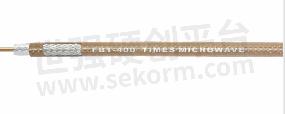
Fig.11
MaxGain
MaxGain® is an ultra-low loss, flexible microwave coaxial cable designed for higher frequency applications with a full range of connectors available as fully tested custom cable assemblies

Fig.12
The LLSB cable series is the most cost effective choice for field deployable applications. Although primarily recommended for fixed interconnects and other non-flexing applications, LLSB cables may be suitable for less demanding retractable antenna feeder applications. When LLSB cables are reeled on a diameter at least 20 times their cable diameter, they will withstand several hundred reelings — an order of magnitude more than is typical for corrugated copper cable.
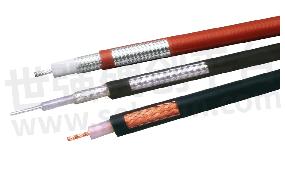
Fig.13
- +1 Like
- Add to Favorites
Recommend
- Times Microwave Systems Opens The Era of High-performance Coaxial Cables and Launches LMR Series Products
- Times Microwave Systems Launched the Coaxial Cables LMR®-900 and LMR®-1200 , They Meet the High Power Demands
- Times Microwave Systems Introduces Multiport,Bundled Cable Assemblies for 5G
- Times Microwave Systems Introduces New Clarity 110 Test Cables for Advanced Testing of 5G, 6G, Automotive Radar and More
- Times Microwave Systems Solves Vibration and Environmental Concerns of Small Form-Factor RF Connectors
- Times Microwave Systems Announces InstaBend™ 141 High-Performance Microwave Assemblies with a Larger-diameter and Lower-loss Addition
- Times Microwave Systems Introduces New Clarity 70 Test Cables Addresses Key Challenges in Testing with a Broad Frequency Response
- Times Microwave Systems Announces Complete TCA Solution for Avionics Applications
This document is provided by Sekorm Platform for VIP exclusive service. The copyright is owned by Sekorm. Without authorization, any medias, websites or individual are not allowed to reprint. When authorizing the reprint, the link of www.sekorm.com must be indicated.

